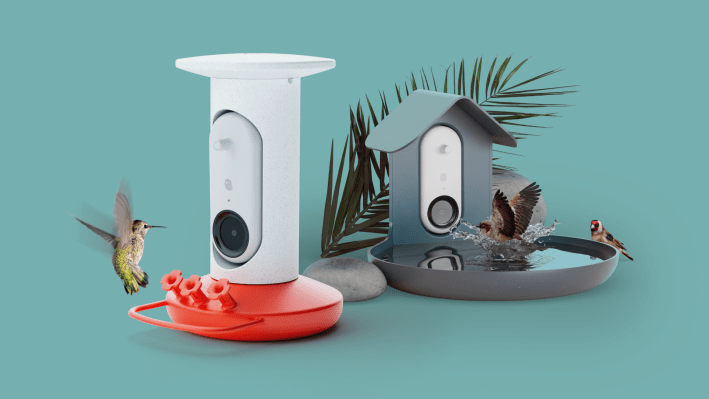Bird Buddy, the AI-powered smart bird feeder, is bringing the popular pastime of bird-watching into the digital age — and growing its line of products in support of the hobby. With the startup’s original affordable bird feeder, connected camera and companion mobile app, birdwatching enthusiasts and newcomers alike can view photos and videos of bird visitors from their own backyards, which Bird Buddy identifies for you and then allows you to save privately or share with the broader Bird Buddy community. Today, the company is expanding its lineup to also include a smart hummingbird feeder and a smart bird bath.
First launched in 2020, initially as a Kickstarter project, the Slovenia- and Kalamazoo, Michigan-based startup today has around 100,000 active Bird Buddy users who are using its original Smart Feeder and AI-powered mobile app to engage with nature and learn more about their local bird populations. Of particular interest is the fact that roughly a third of those users are new to birdwatching, which demonstrates the draw this smart birdfeeder system has to pull newcomers into this hobby.
The original Bird Buddy feeder is $199 — or $269 with a solar roof to charge the camera — and began shipping to its backers last September. It comes in blue and yellow and is made with new and post-consumer BPA-free recycled plastics. The feeder also comes with a length of cord to hang the feeder from a tree or post, as well as a bottom mount that works with a pole, wall or fence mount. Plus, owners can purchase optional accessories for the system, like the solar roof or a suet holder, for an additional price.
At CES, the company first teased its next product: a hummingbird feeder, and showed off a prototype.
Now, that product is getting nearer manufacturing, as Bird Buddy is returning to Kickstarter to launch a crowdfunding campaign in the hopes of meeting a target $100,000 raise. As a benefit, backers will receive 25% off and exclusive bundles. That means the hummingbird feeder will retail for $235 but will be offered to early backers at $174 (super early bird) and $189 (early bird). The Smart Bird Bath, meanwhile, will retail for $249 but will be offered at $184 or $199 to early Kickstarter backers.
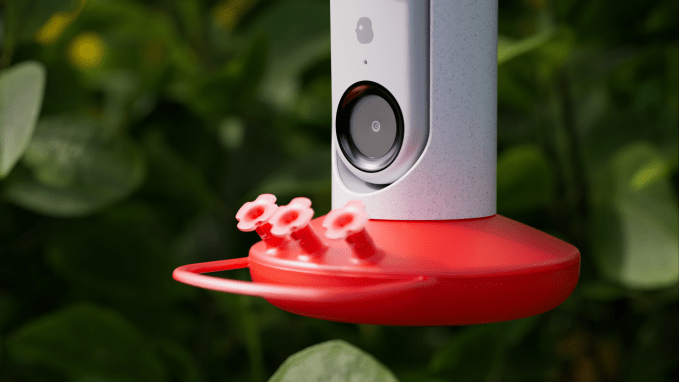
Image Credits: Bird Buddy
Like the original smart bird feeder, the new Bird Buddy Smart Hummingbird Feeder is designed to provide up-close views of its visitors while the Bird Buddy software has been updated to recognize all common hummingbird species across North America. The company notes the feeder may also attract bees and butterflies, increasing the biodiversity of its customers’ backyards.
Also similar to the original feeder, the new Hummingbird Feeder can be bought with or without the solar roof and will use the same camera module with 5 megapixels and HD video, and a 120-degree field of view. Because the camera module is the same, existing customers will be able to swap their cameras between their different feeders.
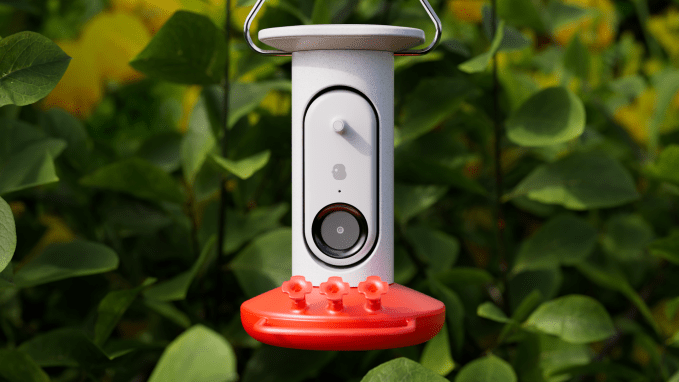
Image Credits: Bird Buddy Hummingbird Feeder
Meanwhile, the new Smart Bird Bath offers a way to attract more species of birds to the backyard — particularly in the summer months.
Though the company today generates its revenue by selling its bird feeders, the smart devices themselves are not the real star of the show for Bird Buddy — it’s the app and the community Bird Buddy is building.
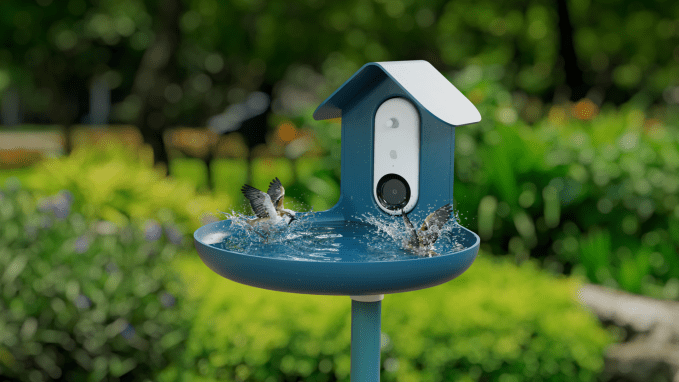
Image Credits: Bird Buddy Smart Feeder
For over a month, I’ve been trying Bird Buddy’s smart feeder (provided to TechCrunch by the company), to learn more about the product. I found that even after the initial excitement wore off, scrolling through Bird Buddy’s feed has become a regular part of my daily routine (as those who follow me on Bluesky already know.). And it’s arguably a more relaxing and fulfilling experience than scrolling videos on TikTok or watching Instagram Stories, I should note.
Co-founder Ziga Vrtacic, who originally hailed from mobile gaming company Outfit7 (Talking Tom kids app maker) told TechCrunch that the inspiration for the smart birdfeeder struck him after he came across that YouTube video of a seagull stealing a GoPro camera. The video includes several up-close shots of the bird looking into the camera lens.
“I realized that we never see birds from this personal perspective — they’re always photographed from far away,” Vrtacic says. “Seeing birds from this angle really makes a ton of difference in the way you perceive it.”
The founder teamed up with colleague and friend Franci Zidar, now Bird Buddy CEO, to develop the Bird Buddy system. The two realized they had no background in working with hardware, which led them to bring on Bird Buddy’s third co-founder, Kyle Buzzard, whose background included work on the first Chromecast design, various Logitech cameras, and the Nest Cam.
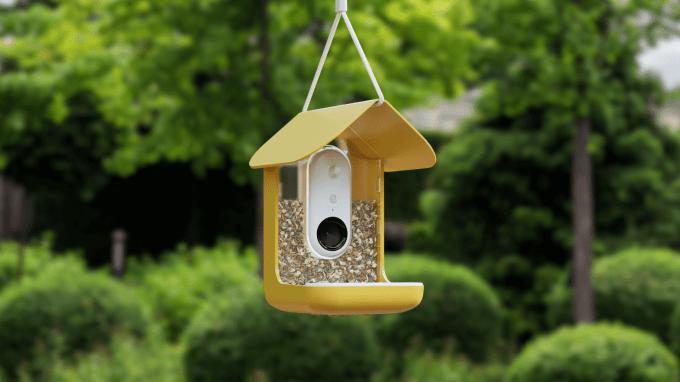
Image Credits: Bird Buddy
Still, the founders knew that they had to offer more than just a birdfeeder with a camera attached — something Vrtacic dismisses today as “not much of an idea” and “very obvious.” Instead, the team decided to focus more heavily on the software side of its business, building out an AI-powered mobile app that is able to identify bird species and allows users to collect photos and videos as well as engage with a birdwatching community.
Fast-forward to today and Bird Buddy is now capable of identifying 452 species using its own proprietary bird identification system — not a third-party integration. As the company expands into new markets around the world, it adds more birds to its model by identifying those that get sent into its “expert review” system where it loops in ornithologists to make the determination.
As bird visitors drop by your feeder, the camera engages to take videos and photos which are then shared through the Bird Buddy app as updates. Though you can use the app to watch the camera feed live, this isn’t core to the experience. Rather, you’re meant to tap on push notifications sent to your phone to watch your bird visitors or review them later when you have downtime.
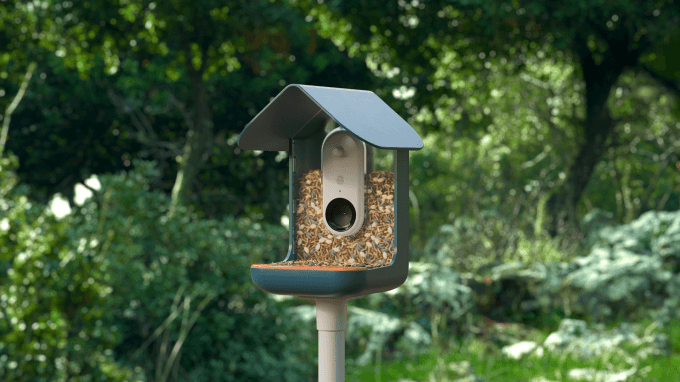
Image Credits: Bird Buddy
Under the hood, Bird Buddy trained its photo and video-capturing system by labeling a couple of million photos to teach it what a “good” bird photo would look like. For example, it learned that a good photo would have the bird clearly in the frame, or you’d be able to see the beak — though the specific details regarding its training are part of Bird Buddy’s secret sauce.
In the initial version of the app, which I tested, these photos and videos were sent through as cute “postcards” you would tap to open. The design was adorable as each opening included a bit of fanfare — and when a new bird visited, there would be a bit of a celebration alongside your first look. You’d then swipe left or right, Tinder-style, to save or discard photos and could opt to save or delete the photo or video entirely, if it wasn’t one you wanted to keep or share.
You can then choose to save the media to your private collection in the app or share the photos and videos with the Bird Buddy community, which is also accessible through the app.
Over time, however, I found that ending up with a dozen or so postcards at the end of the day to go through — often only to see the same bird over and over again, which is common to the Bird Buddy user experience — began to lose its novelty. At first, I was thrilled to watch a mating set of cardinals (where the male fed the female some seeds — awww!), but by the twentieth time I had a cardinal postcard to open, the experience of tapping to open, then manually selecting which photos and videos to save had become a little tedious.
Bird Buddy had heard this complaint, too, and quickly readjusted.
“That was the second most often reported feedback,” Vrtacic admitted. (The first was battery life, but this was addressed with a late December/early January update, leaving the postcard collection flow the number one issue. Now the battery makes it through a good part of a week for me, though this will vary based on your own “bird traffic.”)
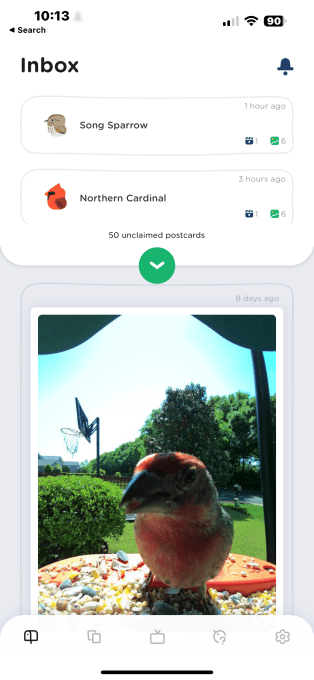
Image Credits: Bird Buddy
The feedback led to the app’s redesign, which recently rolled out.
Now, the user interface does away with the tap-to-open experience in favor of a stream of updates, similar to a notification or inbox feed. Here, you can preview each item and choose whether or not to view the content or just swipe it to dismiss it. In other words, you can skip watching the 13th visit from your cardinal friend by swiping it away and just tapping to see the other bird photos instead.
Once you’re viewing the images, you’ll still need to swipe to save or delete photos, as before. But the second part of the redesign, expected in a couple of months, will allow you to multiselect photos for faster processing — again, speeding things up.
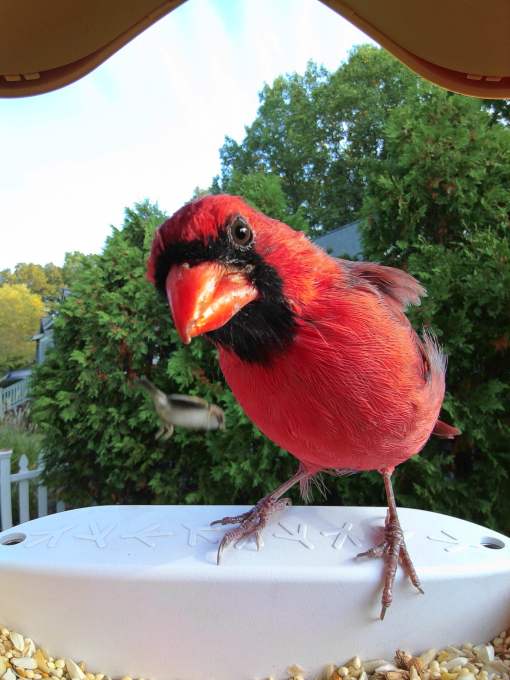
Image Credits: Bird Buddy
After managing your notifications, you can also scroll through your past photos in a feed or tap over to other sections of the app.
Your private collection is available through the second tab from the left, letting you track and return to all the different types of birds you’ve “collected.” In this section, you can learn more about the species through informative blurbs and cards, play clips of the bird’s call and songs, view a map of where they’re found in the world, and share individual photos or videos with friends or on social media.
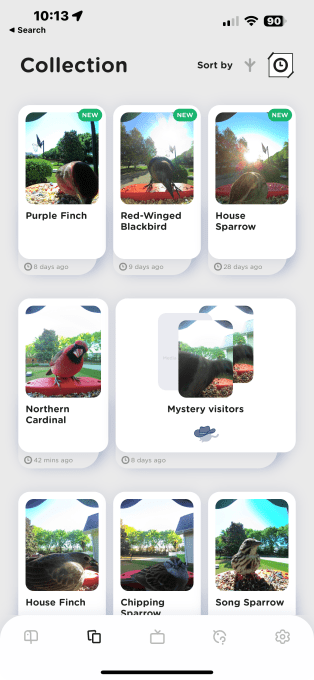
Image Credits: Bird Buddy
This helps augment the app with educational content, which is particularly useful to newcomers to bird-watching.
Another new feature in the software update is a feed of “mystery visitors” — which is what Bird Buddy calls the birds its software, for whatever reason, can’t identify — maybe they’re out of frame, blurry or there’s a glare, or it just doesn’t have them in its database yet. With this additional resource, bird experts can now help you to classify your unknown birds, at your request.
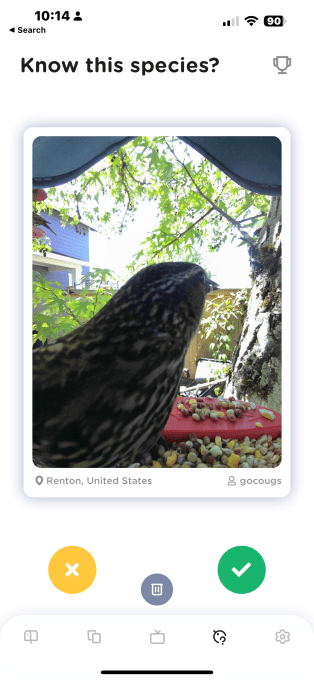
Image Credits: Bird Buddy
However, the most enjoyable part of the app update has been the new Bird Buddy TV feature, which is an almost TikTok-like vertical feed of bird videos, recorded from customers’ devices, which you swipe through vertically.
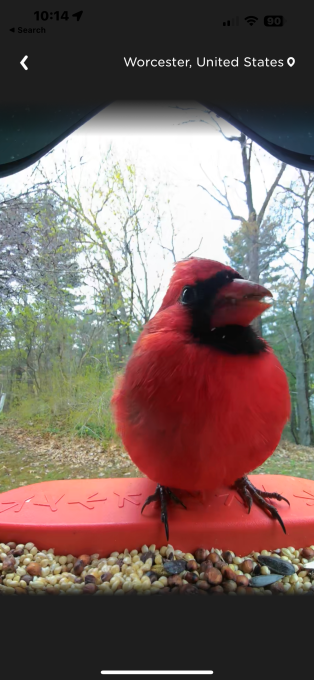
Image Credits: Bird Buddy
“Bird Buddy TV is our experiment in allowing people to consume this content without really any work,” explains Vrtacic. “And we’re seeing great success with that feature, even though the first version is not even interactive yet. You cannot like share or comment,” he notes. “But that is also something that’s coming soon,” he teases.
Customers are spending increased minutes in the app because of this addition, rivaling in some cases, the time spent on social media.
The company says it’s careful to respect user privacy when sharing videos into this feed, making sure that it’s not picking up any personal information — like house numbers, license plates on nearby parked cars and, of course, humans. Over time this video feed could also bring in non-Bird Buddy product owners into the app to engage with the content and community, without having to invest in a feeder itself.
Another of Bird Buddy’s bigger goals is to make its bird feeder data available to researchers. This is something it’s already working on, as it now makes the data available to the public for download through its Bird Buddy Heartbeat website in addition to a stream of live sightings. But conversations with universities, bird groups and other researchers are still in the early stages about what sort of data they need and how Bird Buddy can better contribute.
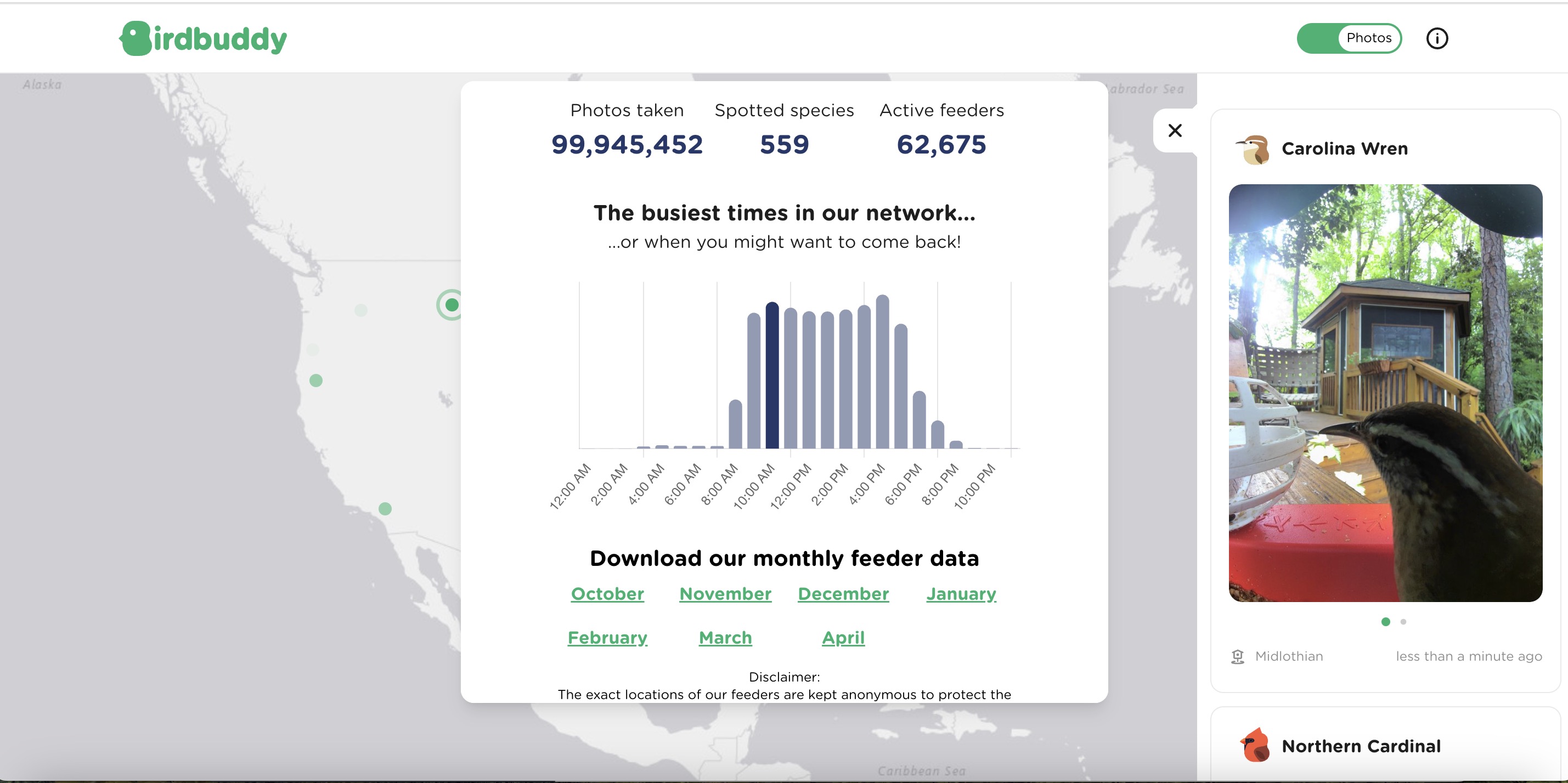
Image Credits: Bird Buddy (live website)
In the meantime, the company believes it has created value beyond its hardware-software combination by way of its community of bird watchers who chat, interact and share tips and ideas with one another. That community today lives on Facebook, but could be migrated to live more fully inside the Bird Buddy app itself over time.
“We do think that our community is our greatest asset,” notes Vrtacic. “It took us some time to be able to build a team that can really support this community right, because [there are] huge volumes of messages coming in and being posted to a lot of channels. We are now making this a priority…we find it super important to invest in that relationship,” he says.
To date, Bird Buddy has raised $8.5 million in funding led by General Catalyst and London-based VC firm BACKED. The startup has not decided if or when it will raise more funding, but says it could.
“I must say that there’s a lot of investor interest…this is not one of our problems,” Vrtacic says.
Bird Buddy’s earlier Kickstarter was one of the platform’s top 1% most-funded projects, as 22,925 users backed the project by raising nearly $4.6 million, making it one of the biggest projects of 2021. The Bird Buddy Kickstarter for new products is live now. As of the time of writing, it’s raised $912,045 of its $100,000 goal.
Update, 8/8/23: Bird Buddy’s smart bird feeder is now shipping to North America is five days and to the UK/EU in eight days, the company announced.
